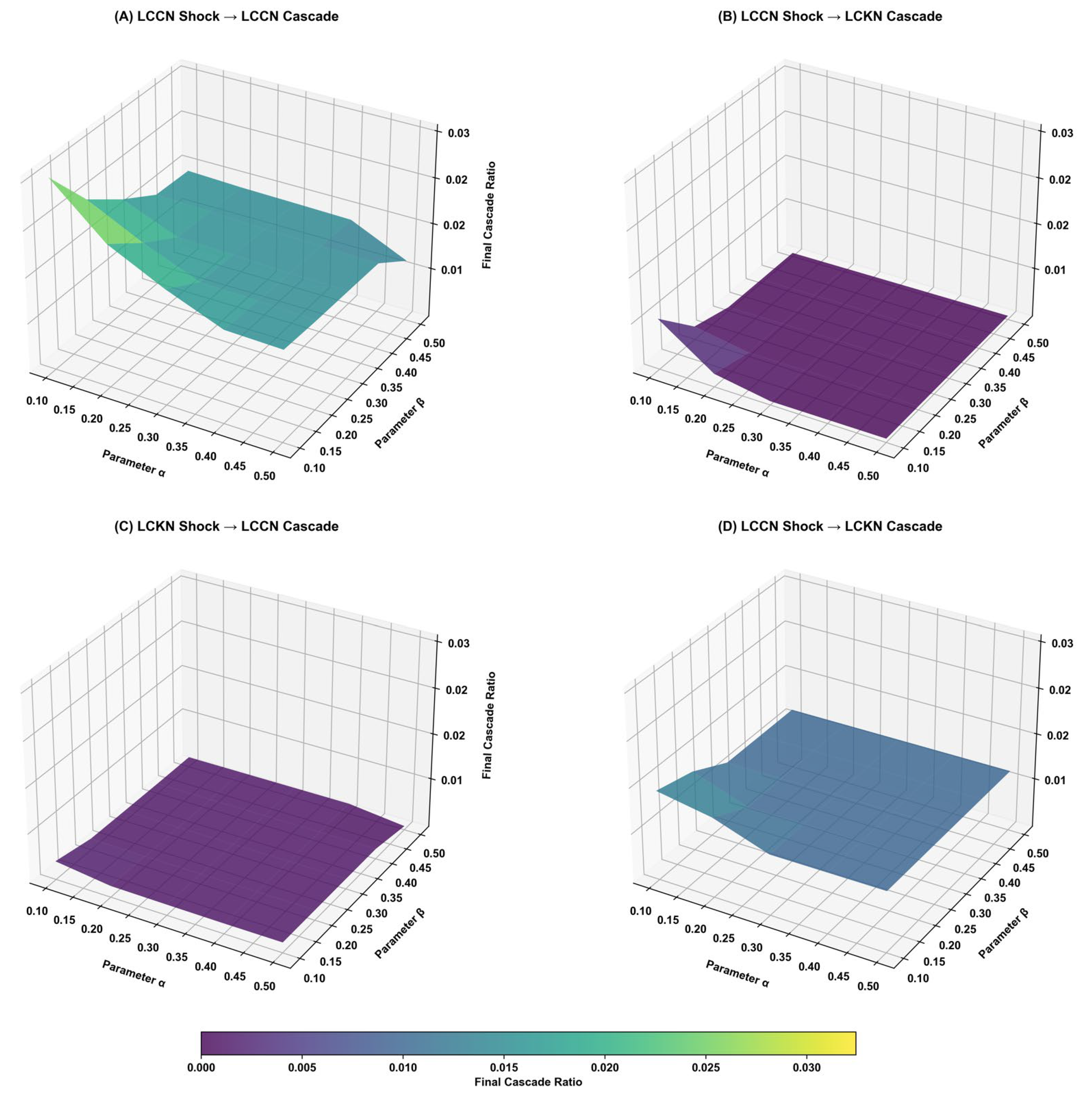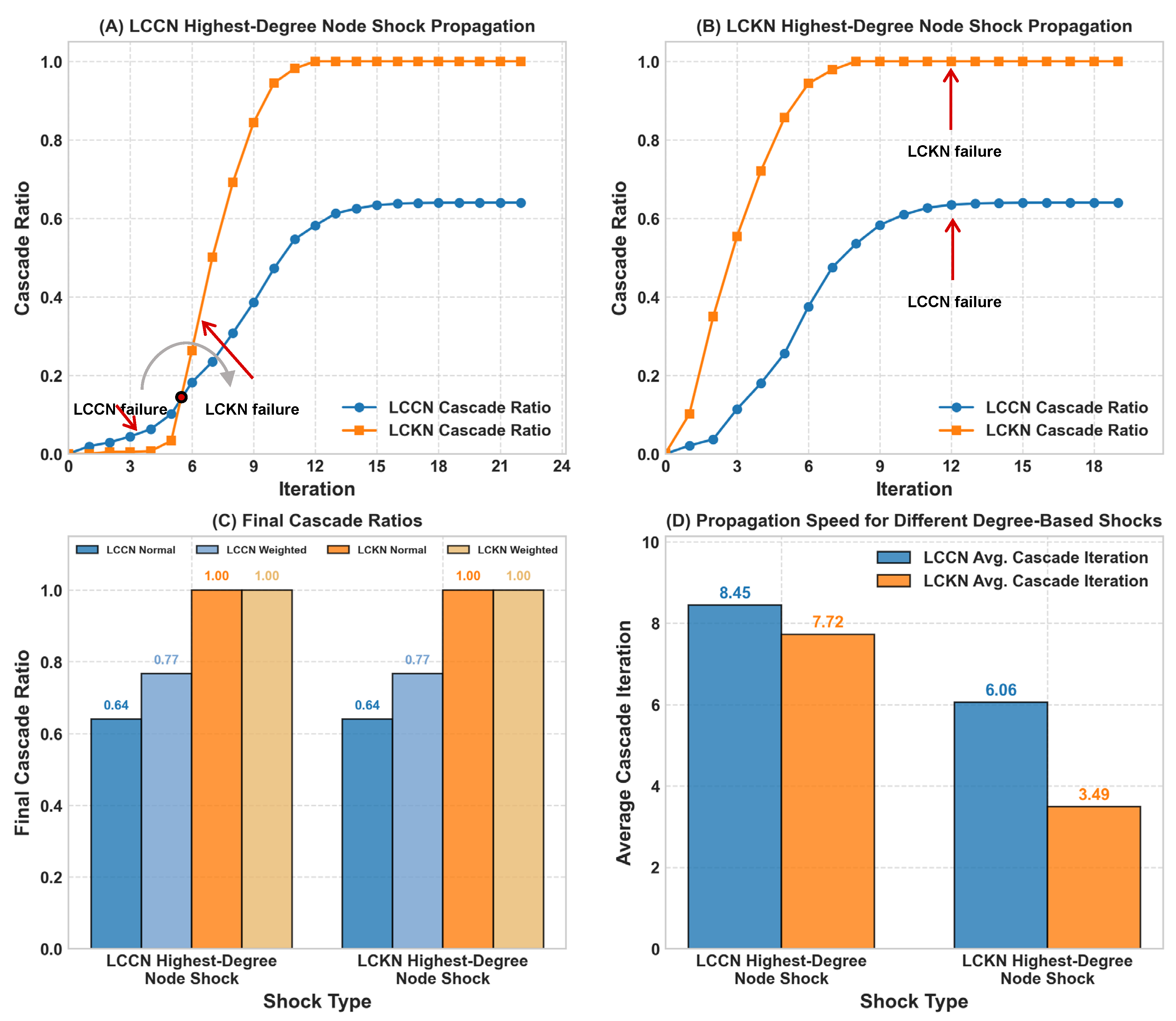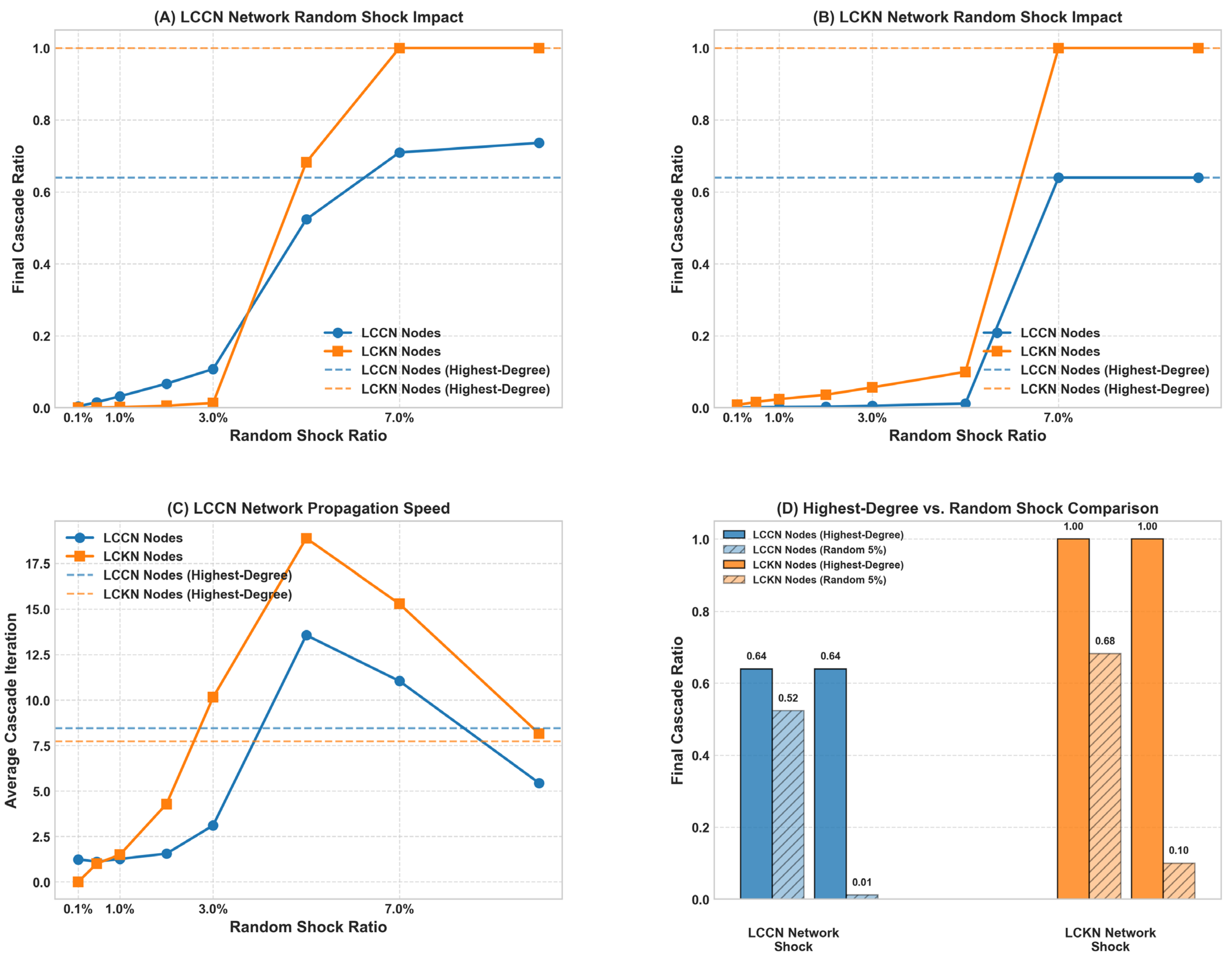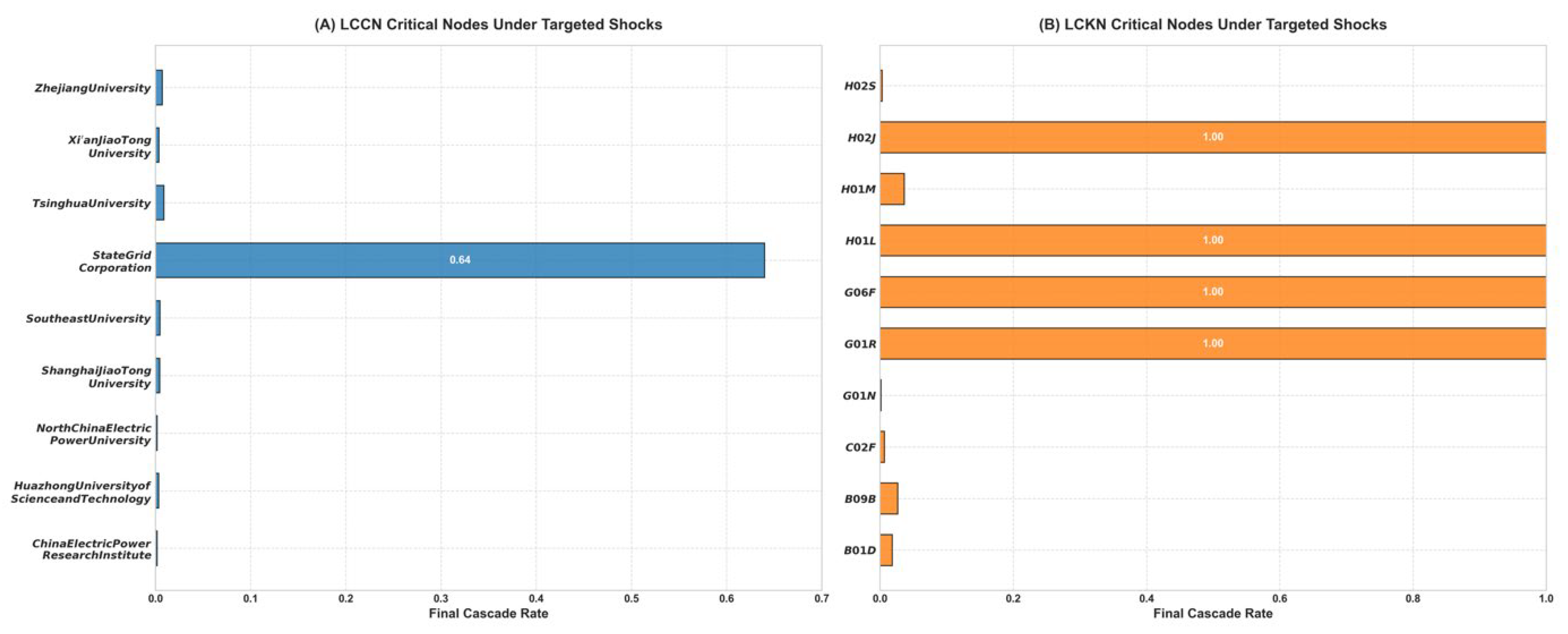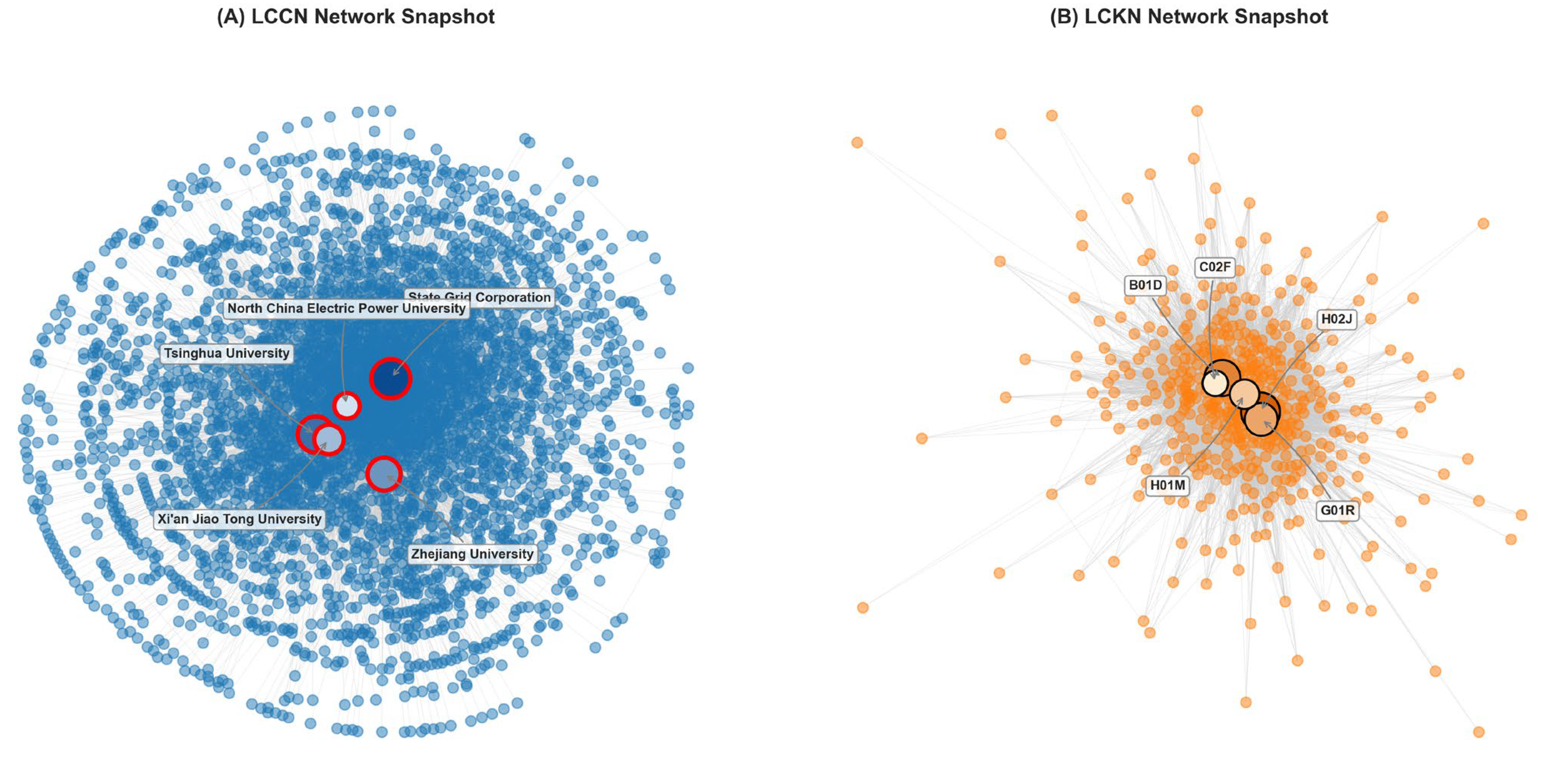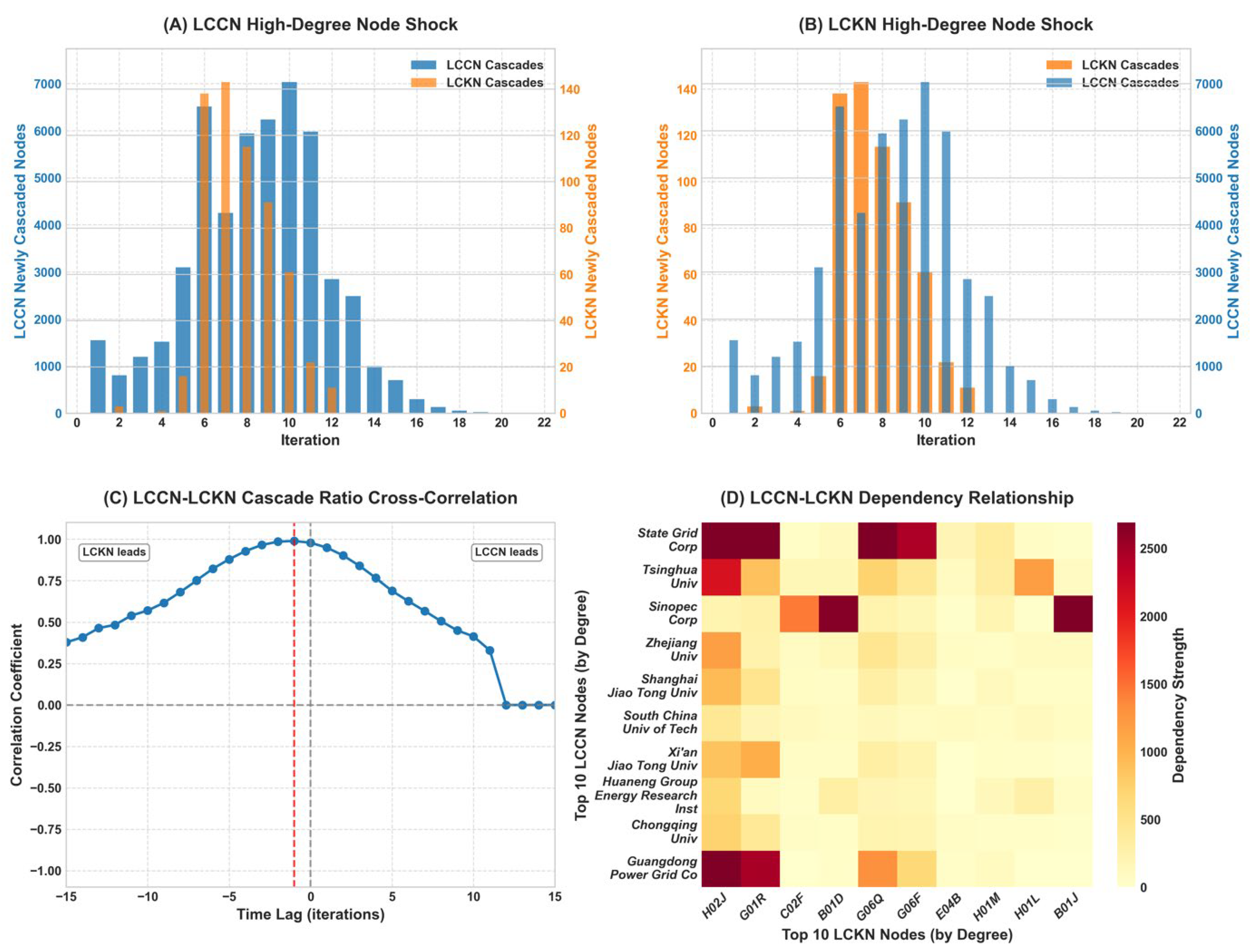1. Introduction
The global shift toward a low-carbon economy constitutes one of the foremost technological and organizational challenges of the 21st century. As climate-change concerns mount and nations advance their carbon neutrality pledges, low-carbon innovation has established itself as a pivotal catalyst for sustainable development and ecological modernization [
1]. These innovations span a broad spectrum of technologies designed to curtail greenhouse gas emissions, enhance energy efficiency, and facilitate the shift from fossil fuels to renewable energy sources [
2,
3]. The development and dissemination of these technologies, however, unfold not in isolation but through intricate interactions among diverse stakeholders—research institutions, corporations, and governmental bodies—forming what can be conceptualized as a complex networked system: an innovation network ecosystem.
In recent years, geopolitical tensions, trade disputes, and global supply chain fragilities have progressively revealed the vulnerability of innovation networks. Intensifying technological rivalry between major economies has posed substantial challenges to the resilience and stability of low-carbon innovation ecosystems [
4,
5]. Trade barriers, technology export controls, and strategic decoupling policies have fractured previously cohesive innovation networks, potentially hindering the dissemination of essential low-carbon technologies [
6,
7]. These developments prompt fundamental questions regarding the resilience of low-carbon innovation networks and their capacity to endure mounting external pressures.
Low-carbon innovation networks possess unique characteristics that distinguish them from traditional innovation systems. These networks function under considerable policy constraints, confront substantial market uncertainties, and necessitate integration across varied technological domains [
8,
9]. Significantly, they exhibit a hierarchical, multi-tiered architecture comprising organizational levels (innovation entities such as corporations, universities, and research institutes) and technological levels (knowledge domains and intellectual components) that profoundly influences both their operational capacity and vulnerability. Central to this framework is a dual interdependent network configuration: primarily, a low-carbon collaboration network (LCCN) connecting innovation entities (corporations, universities, and research institutes) engaged in technological advancement; and secondarily, a low-carbon knowledge network (LCKN) interconnecting intellectual components embedded within patent literature. From complex systems theory perspective, such interdependent networks constitute a class of “networks of networks” characterized by emergent properties, nonlinear dynamics, and threshold effects that cannot be predicted by examining individual network layers in isolation [
10]. These two network layers interact through complex dependency relationships—innovation actors develop and apply specific knowledge elements, while the evolution of knowledge domains influences the formation of new collaborations [
11]. This interdependent structure significantly amplifies the impact of geopolitical tensions and trade conflicts. When export controls or sanctions impair a crucial innovation entity, the consequences cascade not only through immediate collaborations but also extend to knowledge domains dependent on that entity’s expertise, potentially precipitating additional failures among other innovation entities relying on those knowledge domains. This intricate propagation mechanism generates systemic vulnerabilities substantially surpassing those observed in less complex network structures, potentially culminating in catastrophic cascade failures throughout the innovation ecosystem—a phenomenon that complexity scientists designate as “systemic risk” or “network-induced fragility” [
12,
13,
14]. Understanding this amplification effect is essential for developing strategies to enhance the resilience of low-carbon innovation systems in an increasingly fractured global environment.
The study of network vulnerability has a rich tradition in complex systems research, with applications ranging from infrastructure systems to trade networks [
15,
16,
17,
18]. Network science provides a powerful analytical framework for understanding how topological properties influence network resilience under various forms of perturbation [
13,
19]. Research on innovation network vulnerability has been examined from multiple perspectives, but it appears to face methodological constraints. On the one hand, from a static perspective, studies have investigated the structural properties of innovation networks and network resilience [
20,
21,
22,
23], though these approaches may not fully capture the dynamic nature of innovation processes. Static analyses tend to focus on structural properties rather than temporal interactions between innovation actors and knowledge elements, and they may not adequately account for feedback mechanisms that could amplify initial disruptions through cross-layer dependencies, potentially leading to an underestimation of systemic risks in innovation ecosystems. For example, Su et al. (2024) [
24] developed a complex network-based technology resilience assessment framework that quantifies the historical trajectory and future path of energy technology resilience in China. Using patent data from the aerospace industry to build collaboration and knowledge networks, Huang et al. (2025) [
25] investigated the impact of the internal knowledge network’s resilience to destruction, agility, and knowledge location on an organization’s resource-transformation efficiency in collaborative networks.
On the other hand, dynamic approaches have modeled how risk propagates through innovation networks, highlighting the potential for chain reactions and systemic failures [
26,
27,
28,
29]. For instance, Liu et al. (2024) [
30] studied R&D network resilience under risk propagation from an organizational learning perspective by constructing a risk propagation model. Wang et al. (2019) [
31] proposed a cascading failure model for R&D networks based on the SIR-CA model and analyzed its particular effect on the cascading failure of R&D networks through numerical simulation. However, these models appear to have certain limitations in that they often treat innovation networks as single-layer systems and may not fully capture the interdependent nature of collaboration and knowledge networks. These models may not adequately represent how disruptions in organizational relationships affect knowledge accessibility, or how knowledge-domain failures impact collaborative capacity, potentially providing incomplete assessments of vulnerability patterns and missing amplification effects that could occur through cross-network propagation.
Despite these valuable studies, significant research gaps remain in our understanding of low-carbon innovation network vulnerability. First, while considerable attention has been devoted to innovation networks generally, the multilayered structural characteristics and interdependency-induced vulnerabilities of low-carbon innovation networks remain underexplored. The complex hierarchical architecture—comprising both innovation actors and knowledge elements interconnected through dependency relationships—creates unique vulnerability patterns that conventional single-layer network analyses cannot adequately capture [
32].
Second, the current geopolitical landscape has introduced targeted disruption scenarios that existing models fail to address. In an environment of strategic technological competition, restrictive measures increasingly target either critical technologies (knowledge elements) or key enterprises controlling these technologies (innovation actors). When export controls target a firm with critical technological capabilities, the impact cascades through the collaboration network and disrupts access to essential knowledge elements throughout the broader innovation ecosystem. Similarly, when restrictions affect specific technological domains, the effects reverberate through firms dependent on those knowledge elements, potentially paralyzing entire innovation subsystems. These strategic targeting mechanisms, particularly prominent in low-carbon technologies, given their economic and security significance, require analytical frameworks capable of capturing multi-level propagation dynamics.
Third, the existing research appears to lack comprehensive methodological frameworks for analyzing interdependent innovation networks. Current approaches tend to analyze knowledge networks and collaboration networks as separate entities rather than as interconnected components of a unified system [
33,
34], which may create challenges including potential difficulties in identifying critical vulnerabilities that trigger cross-layer cascading effects, limited understanding of amplification mechanisms through bidirectional feedback loops, and possible underestimation of risks that emerge from network interdependencies. Real-world examples of such risk underestimation include (1) knowledge transfer failures, where innovation projects collapse despite strong collaboration networks due to insufficient absorptive capacity and knowledge-stickiness barriers that are invisible when analyzing collaboration networks in isolation [
35]; and (2) cross-network propagation failures, where disruptions in university–industry collaboration networks during COVID-19 unexpectedly triggered systematic breakdowns in knowledge transfer processes across entire innovation ecosystems [
36]. This limitation is particularly consequential for low-carbon innovation, where technological development inherently depends on the interplay between knowledge elements and innovation actors. The complex dependency structures in low-carbon technologies, which integrate multiple knowledge domains and involve diverse innovation actors [
37], necessitate an interdependent network approach to properly assess systemic vulnerabilities.
To address these research gaps, this study develops an interdependent network approach to analyzing the vulnerability of low-carbon innovation systems. Using comprehensive Chinese low-carbon patent data, we construct a realistic two-layer interdependent innovation network comprising both an LCCN connecting innovation actors and an LCKN representing co-occurrence relationships among knowledge elements. We perform dynamic analysis by developing a shock propagation model grounded in complex network theory. This model specifically designs cross-layer propagation mechanisms that capture how disturbances transmit both within each network layer and between the collaboration and knowledge layers through their dependent relationships. The propagation mechanisms incorporate threshold-based activation, weighted influence, and bidirectional feedback effects to realistically simulate how shocks cascade through the interdependent system. This empirically grounded network structure and theoretically informed modeling approach allows us to provide a more comprehensive assessment of systemic risks in low-carbon innovation ecosystems.
Our research makes several significant contributions to the literature. First, we advance theoretical understanding of innovation network vulnerability by developing a comprehensive analytical framework that explicitly accounts for the interdependence between knowledge elements and innovation actors (implemented in
Section 2.3,
Section 2.4 and
Section 3.4). Second, we offer methodological innovations through the application of a dynamic shock propagation model specifically designed for multilayered networks, allowing for more accurate simulation of cascading failures across network boundaries (implemented in
Section 2.3 and
Section 2.4, and throughout
Section 3). Third, we provide empirical insights into the structure and vulnerability patterns of China’s low-carbon innovation ecosystem, identifying critical nodes and potential intervention points for enhancing system resilience (implemented in
Section 2.1,
Section 2.2,
Section 3.3 and
Section 3.4).
This paper is organized as follows:
Section 2 presents our data sources and methodological approach, including the construction of the interdependent network model and the shock propagation dynamics.
Section 3 examines the dynamic propagation of shocks through the interdependent networks and identifies critical vulnerabilities. Finally,
Section 4 discusses the implications of our findings for innovation policy and management strategies aimed at enhancing the resilience of low-carbon innovation systems.
2. Materials and Methods
2.1. Data Sources and Case Background
This study utilizes patent data drawn from the Dawei Innojoy Patent Database
1, a comprehensive repository containing information on more than 180 million patents worldwide. This database provides detailed records of patent applications and grants, including applicant information, invention descriptions, filing dates, and International Patent Classification (IPC) codes, making it an invaluable resource for analyzing technological innovation systems.
The selection of China as the case context for this study is strategically motivated by several compelling characteristics that make it an ideal case for investigating innovation network vulnerability. China represents the world’s largest low-carbon innovation ecosystem by patent volume, accounting for over 50% of global low-carbon patents as of 2023 [
38], which provides the scale and network density necessary to meaningfully test our interdependent network vulnerability models. This comprehensive coverage ensures that our findings are based on a robust dataset that captures the complexity of innovation network interactions. Beyond scale considerations, China’s position at the center of current technological competition and trade tensions makes it particularly relevant for studying how geopolitical pressures affect innovation network resilience [
4]. The recent implementation of technology export controls, trade disputes, and strategic decoupling policies that directly target Chinese technologies creates a natural context for understanding vulnerability propagation in innovation networks under external pressure.
The structural characteristics of China’s low-carbon innovation system also align closely with our research objectives. The system exhibits high levels of interdependence between domestic and international actors, as well as complex knowledge-collaboration linkages that are essential for testing our theoretical framework. The presence of both state-owned enterprises such as State Grid Corporation (Beijing, China) and private companies, universities, and research institutes creates the multilayered network structure that our methodology is specifically designed to analyze. This diversity of actor types and institutional arrangements provides rich empirical variation for examining different vulnerability patterns across network layers. Furthermore, understanding the vulnerability patterns in China’s low-carbon innovation network carries significant implications for global climate objectives, given China’s central role in low-carbon technology development and deployment worldwide [
39]. The insights derived from this case can inform both domestic resilience strategies and international cooperation frameworks for low-carbon innovation.
To identify patents specifically related to low-carbon technologies, we employed the IPC Green Inventory developed by the World Intellectual Property Organization (WIPO) as our search framework [
40]. The IPC Green Inventory was established by the IPC Committee of Experts to facilitate the retrieval of patent information related to Environmentally Sound Technologies, as defined by the United Nations Framework Convention on Climate Change (UNFCCC). This classification system provides a structured approach to identifying patents across various domains of environmental technologies, including alternative energy production, transportation, waste management, agriculture, and administrative or regulatory aspects of environmental technologies.
The IPC Green Inventory offers several advantages for our research purposes. First, it provides a standardized and internationally recognized framework for identifying low-carbon technologies, enhancing the reproducibility and comparability of our findings. Second, it covers a comprehensive range of technological domains relevant to climate-change mitigation and adaptation, allowing us to capture the full spectrum of low-carbon innovations. Third, it has been developed by patent classification experts with specific attention to environmental technologies, ensuring high relevance and precision in identifying low-carbon patents [
41,
42].
Using the corresponding IPC codes from the Green Inventory, we conducted a systematic search in the Dawei Innojoy Patent Database to retrieve all relevant patents. Our search strategy focused on patents filed in China to capture the development of low-carbon technologies within the Chinese innovation system. The search encompassed patents filed by both domestic and international entities operating within China, providing a comprehensive view of the country’s low-carbon innovation landscape.
For each retrieved patent, we extracted several key data elements essential for constructing our interdependent network model. (1) Applicant information: Names and addresses of all organizations and individuals listed as patent applicants, which served as the basis for identifying nodes in the LCCN. (2) IPC codes: The complete set of IPC codes assigned to each patent at the subgroup level, which formed the basis for identifying nodes in the LCKN. (3) Application dates: The dates when patents were filed, allowing us to track the temporal evolution of the innovation networks (though our primary analysis focuses on the cumulative network structure).
Following the data extraction, we conducted an extensive cleaning and standardization process to ensure data quality and consistency. This included the harmonization of organization names to account for variations in how entities are recorded across different patent documents, the validation of IPC code assignments, and the removal of duplicate records. Additionally, patents with incomplete information or those that did not meet our inclusion criteria were excluded from the analysis. As a result of the data cleansing, a total of 189,943 patents ended up being eligible and were then used to build innovation networks.
2.2. Network Structure
We next describe the construction of an interdependent network system that captures collaborative relationships and knowledge flows in China’s low-carbon innovation ecosystem. The interdependent network consists of two distinct but interconnected layers: the LCCN and the LCKN, with cross-layer dependencies established through patent-based connections.
The LCCN represents the collaborative relationships between organizations engaged in low-carbon innovation activities. In this network, nodes represent entities such as universities, research institutions, corporations, and government agencies that have participated in the development of low-carbon technologies. An edge between two organizations indicates co-patenting activity, signifying their collaboration in producing low-carbon innovations. The strength of these connections is determined by the frequency of collaboration, with multiple joint patents resulting in stronger ties between entities. This approach aligns with established methodologies in innovation network analysis that use co-patenting as a proxy for collaborative relationships [
43].
The LCKN captures the technological knowledge structure underlying low-carbon innovations. In this network, nodes represent technological components or knowledge elements, as identified by IPC codes at the subgroup level. These codes provide a granular categorization of the technological domains that constitute low-carbon innovations. An edge between two knowledge elements indicates their co-occurrence within the same patent document, suggesting technological proximity or complementarity between these components. The frequency of co-occurrence determines the strength of connections between knowledge elements, reflecting the intensity of their technological relationship. This approach builds on previous research that has used patent classification co-occurrence to map knowledge [
44,
45].
The interdependence between these two network layers is established through the patents themselves, which serve as bridging mechanisms connecting organizations to the knowledge elements they develop or utilize. Specifically, cross-layer dependencies are created when an organization (node in the LCCN) is linked to a knowledge element (node in the LCKN) through their association in patent documents. The strength of these interlayer connections is quantified based on the frequency with which an organization produces patents containing specific knowledge elements, reflecting the organization’s specialization in or reliance on particular technological domains.
This interdependent network structure provides a comprehensive framework for analyzing how risk propagates both within and between the collaborative and knowledge dimensions of the low-carbon innovation ecosystem. By modeling both the internal dynamics of each network layer and the cross-layer interactions, we can assess systemic vulnerabilities and identify critical components whose failure could trigger widespread cascading effects across both LCCN and LCKN layers throughout the innovation system.
2.3. Single-Layer Network Shock Propagation Model
Network shock propagation models have gained significant traction in analyzing systemic risks across complex systems, including financial networks, supply chains, and innovation ecosystems [
46,
47,
48]. This section establishes the theoretical foundation and implementation of our single-layer network shock propagation model, which serves as the cornerstone for the more sophisticated interdependent network approach discussed subsequently.
The propagation of shocks in innovation networks can be conceptualized as a cascade process where disruptions diffuse through network connections with varying intensities [
49,
50]. Our approach adopts a threshold-based cascade model, which has demonstrated considerable utility in modeling contagion phenomena in socioeconomic networks [
51]. Within this framework, each node,
, is characterized by a binary state variable,
∈ {0,1}, representing normal functioning or cascade/failure state, respectively. The transition mechanism between states is governed by the weighted influence exerted by neighboring nodes, mathematically expressed as follows:
where
denotes the set of neighboring nodes connected to node
,
represents the connection weight between nodes
and
, and
indicates the state of node
in the preceding iteration. A node transitions from a normal to cascade state when the aggregated influence surpasses its resilience threshold,
:
These thresholds embody the resilience of entities to withstand external pressures or shocks. In our implementation, we employ a heterogeneous threshold approach where each node’s threshold is determined based on its specific characteristics.
In the context of low-carbon innovation networks, we apply this model separately to both the LCCN and the LCKN. The simulation process begins with an initialization phase, where seed nodes representing the initial shock are set to the cascade state, while all others remain in the normal state. The propagation then proceeds iteratively, with node states updated based on the influence levels and predetermined thresholds. This irreversible process continues until equilibrium is reached—when no new nodes enter the cascade state—or until a maximum iteration threshold is attained.
To quantify the impact of shock propagation, we employ several evaluation metrics. The cascade ratio represents the proportion of nodes that ultimately enter the cascade state, providing a measure of the overall system vulnerability. The weighted cascade ratio incorporates node importance by weighting the cascade proportion by node degree, offering insights into the functional impact of the cascade. Additionally, the average cascade iteration metric captures the temporal dynamics of the propagation process, indicating how rapidly shocks diffuse through the network.
While the single-layer model offers valuable insights into intra-network shock propagation dynamics, it does not account for the critical interdependencies between collaboration and knowledge networks. Therefore, we extend this model in the next section.
2.4. Interdependent Networks Shock Propagation Model
Innovation systems are intrinsically characterized by complex interdependencies across multiple network dimensions [
52]. Particularly in low-carbon technology domains, the LCCN and LCKN exhibit intricate interactions that can substantially amplify or attenuate shock propagation. To capture these complex dynamics, we develop a comprehensive interdependent-networks shock propagation model that builds upon and extends the single-layer approach.
Our interdependent network model conceptualizes a two-layer network system. The interconnections between these layers are operationalized through a dependency matrix, where each element, , quantifies the strength of dependency between node in the LCCN and node in the LCKN. The central innovation in this approach lies in the dual influence mechanism, whereby a node’s state evolution is determined by both intralayer connections (influences from within the same network) and interlayer dependencies (influences from the complementary network). This bidirectional influence framework enables a more realistic representation of shock propagation in complex innovation systems.
The mathematical formulation distinguishes between intralayer and interlayer influences for each node. The intralayer influence follows the formulation established in the single-layer model, calculated separately for each network:
The interlayer influence captures the impact of cascades from one network layer on nodes in the other. For LCCN nodes, the influence from LCKN is modulated by a knowledge redundancy parameter,
, which represents the entity’s capacity to withstand knowledge network disruptions:
Conversely, the influence from LCCN to LCKN nodes is calculated as follows:
where
and
denote the sets of nodes in the opposite layer with dependencies to node
.
In our model, each node has a single resilience threshold that governs its response to both intralayer and interlayer influences. The state transition rules incorporate both influence types, with a node transitioning to the cascade state if either influence exceeds its threshold:
While alternative modeling approaches exist, including weighted aggregation conditions ( + > θ) that assume influences can compensate for each other, and min–max conditions () that require simultaneous threshold breaches, we adopt the OR condition based on the specific characteristics of innovation networks. In innovation systems, knowledge resources and collaborative relationships function as complementary rather than substitutable assets. Organizations cannot compensate for knowledge-domain failures through stronger collaboration alone, nor can superior knowledge assets fully offset collaboration network breakdowns, as modern innovation inherently requires both knowledge access and collaborative capabilities for success. The OR condition therefore reflects the reality that failure in either domain can independently compromise an organization’s innovation capacity. Additionally, this approach provides a conservative risk assessment framework appropriate for policy applications, where identifying all potential failure pathways is essential for developing comprehensive resilience strategies in low-carbon innovation ecosystems.
The node-specific thresholds are heterogeneously determined based on their characteristics, following the established notion in the innovation diffusion and network resilience literature that different actors possess varying levels of resistance to external influences. For LCCN nodes, the threshold is calculated using knowledge diversity:
where
is the base threshold,
is the knowledge diversity coefficient,
is the number of different knowledge elements utilized by node
, and
is the total number of nodes in the knowledge network. This formulation reflects the theoretical assumption, supported by the organizational resilience literature, that entities with more diverse knowledge portfolios exhibit greater adaptability and resilience against external shocks [
53]. Knowledge diversity serves as a form of strategic redundancy, allowing innovation entities to reconfigure their activities when faced with disruptions in specific knowledge domains.
For LCKN nodes, the threshold is based on usage frequency:
where
is the base threshold,
is the usage coefficient,
is the number of different innovation entities utilizing knowledge element
, and
is the total number of nodes in the collaboration network. This parameterization aligns with the knowledge stock perspective in innovation studies which suggests that more widely used knowledge elements tend to be more institutionalized, stable, and resistant to disruptions [
54,
55]. Widely diffused knowledge elements typically represent more mature, well-established areas of expertise with higher legitimacy and broader application potential, thereby exhibiting greater resilience to systemic shocks.
The calibration of the base threshold parameters (
and
) and diversity/usage coefficients (
and
) draws from empirical studies on innovation network resilience which suggest that threshold values in socio-technical systems typically fall within the 0.1–0.5 range [
56]. To validate our parameter selection, we conducted a comprehensive sensitivity analysis examining how variations in α (0.10–0.50) and β (0.10–0.50) affect cascade outcomes across different shock scenarios (see
Appendix A Figure A1). The sensitivity analysis reveals that our chosen moderate values (α = 0.2 and β = 0.3) produce stable cascade dynamics across all four propagation pathways, avoiding both excessive rigidity (which would prevent meaningful cascade propagation) and hypersensitivity (which would lead to deterministic outcomes regardless of shock characteristics). The analysis shows that cascade ratios remain relatively stable within ±0.005 variation around our chosen parameter values, while exhibiting appropriate responsiveness to different shock intensities and network structures. The propagation algorithm initiates with seed nodes set to the cascade state and proceeds iteratively. At each step, both intralayer and interlayer influences are calculated for all nodes, states are updated based on threshold conditions, and the process continues until equilibrium or until the maximum iteration limit is reached. The flow of Algorithm 1 is shown in the following table. The specific simulation parameters are set in
Appendix B.
| Algorithm 1. Low-Carbon Innovation Networks Shock Propagation Model. |
Input: Network data, parameters (shock ratio, max iterations, random seed)
Output: Cascade metrics and proportion of affected nodes
1: Initialize procedure
2: Import two-layer low-carbon network (LCCN, LCKN, dependency matrix)
3: Initialize parameters (thresholds, max iterations)
4: Set initial shock nodes based on shock ratio or degree
5: while TIME-STEP ≠ STOP-TIME do
7: foreach layer (LCCN, LCKN) do
8: Compute intralayer cascade influence based on neighbor states
9: Compute interlayer cascade influence based on dependency matrix
10: Cascade State Update
11: foreach node in LCCN and LCKN do
12: Calculate total cascade influence
13: Update node state if influence exceeds threshold
14: TIME-STEP ← TIME-STEP + 1
15: Calculate cascade metrics and proportion of affected nodes |
4. Discussion
4.1. Findings
This study investigated the propagation dynamics and vulnerability structures in interdependent low-carbon innovation networks by constructing and analyzing a two-layer system comprising an LCCN and an LCKN based on Chinese patent data. We applied shock propagation models to examine how disturbances spread within and between these networks under various shock scenarios, including degree-based targeted shocks, random shocks, and specific critical node shocks. Our analysis revealed several key findings with important theoretical and practical implications.
A striking discovery is the difference in vulnerability between the two network layers. Throughout all shock scenarios, the knowledge network consistently demonstrated greater susceptibility to cascading failures than the collaboration network, both in terms of propagation extent and speed. While the LCKN typically experienced complete system failure (cascade ratio of 1.0), the LCCN exhibited partial resilience, with cascade ratios stabilizing around 0.64 regardless of shock origin. This difference suggests that technological knowledge components in low-carbon innovation systems represent more critical and potentially fragile elements than collaborative relationships between institutions. This finding contributes to the growing literature on interdependent network resilience by demonstrating that different layers within innovation systems can exhibit fundamentally different vulnerability characteristics [
26,
32]. While most existing studies focus on single-layer innovation networks, our results suggest that the multilayer approach reveals critical asymmetries in system robustness that would otherwise remain hidden. The analysis further revealed distinct critical node patterns: the LCCN featured a single critical vulnerability point (State Grid Corporation), whereas the LCKN contained multiple critical nodes (H02J, H01L, G06F, and G01R), each capable of independently triggering complete system failure.
The comparison between targeted and random shocks revealed that while the collaboration network exhibited similar vulnerability to both strategies, the knowledge network was significantly more susceptible to strategic shocks targeting its highest-connected nodes. This differential response to shock strategies across network layers represents an important extension to previous research on network resilience, which has typically focused on single-layer networks [
61]. Our findings suggest that protection strategies need to be tailored to the specific vulnerability profiles of each network layer within interdependent systems.
The identification of critical nodes through targeted shock analysis revealed distinct vulnerability architectures in each network layer. In the collaboration network, State Grid Corporation emerged as a singular point of vulnerability, with its disruption producing substantially greater systemic impact than any other entity. In contrast, the knowledge network exhibited multiple critical vulnerabilities, with several technological components (particularly H01L, H02J, G06F, and G01R) capable of triggering complete system failure. This difference in vulnerability distribution suggests that while the collaboration network’s resilience depends heavily on a single keystone organization, the knowledge network’s stability relies on multiple foundational technological components.
Our temporal analysis of cross-network propagation revealed that disruptions typically spread more rapidly through the knowledge network than through the collaboration network, with peak cascade activity in the LCKN consistently preceding peak activity in the LCCN. This temporal lead of knowledge-network failures, formalized through cross-correlation analysis, suggests that disruptions to technological knowledge components can serve as early warning indicators for subsequent failures in collaborative structures.
The analysis of interlayer dependency thresholds and shock intensities revealed that cross-network propagation between the LCCN and LCKN exhibits distinct regimes with different sensitivity patterns. Most notably, propagation from the collaboration network to the knowledge network showed sharp transitions at specific threshold values, while propagation in the reverse direction displayed more gradual responses. These findings suggest that the strength of coupling between network layers plays a crucial role in determining system-wide vulnerability, with certain critical thresholds marking transitions between stable and unstable regimes.
4.2. Theoretical Contributions
Our research makes several significant theoretical contributions. First, we extend the application of interdependent network theory [
14,
62] to innovation systems, demonstrating that the two-layer approach reveals vulnerability patterns invisible to traditional single-network analyses. Second, we contribute methodologically by developing shock propagation models specifically designed for innovation networks, building upon existing cascade models [
49,
50,
61] while incorporating threshold-based activation and bidirectional feedback mechanisms unique to innovation contexts. Third, we provide evidence of asymmetric vulnerability patterns in innovation systems, where knowledge networks consistently show greater fragility than collaboration networks across multiple shock scenarios.
4.3. Policy Implications
From a practical perspective, our findings offer valuable guidance for enhancing the resilience of low-carbon innovation systems. The identification of critical knowledge vulnerabilities in semiconductor devices (H01L), electric power systems (H02J), digital data processing (G06F), and electric measurement technologies (G01R) suggests that policymakers should prioritize technological diversification in these domains. This includes funding parallel research tracks for critical technologies, establishing technology backup repositories, and creating distributed expertise development programs to prevent single points of failure in essential knowledge areas.
The identification of State Grid Corporation as a singular vulnerability point necessitates targeted risk mitigation measures. Policymakers should implement collaboration diversification requirements for critical infrastructure entities, establish maximum collaboration concentration thresholds, and create regulatory frameworks that prevent over-reliance on single organizations in innovation processes. Additionally, strategic resilience auditing programs should regularly assess keystone organizations and develop contingency plans for potential disruptions.
Our findings on cross-network propagation dynamics suggest that innovation policy should focus on optimizing coupling between collaborative and knowledge networks. This includes promoting modular innovation architectures that maintain functional connections while preventing cascade propagation, and establishing monitoring systems for critical technological knowledge components. The temporal lead of knowledge-network failures provides opportunities for early warning systems that can detect vulnerabilities before they trigger system-wide cascade effects.
For innovation management, our research highlights the importance of considering both collaborative relationships and knowledge interdependencies when assessing vulnerability in technological innovation systems. Traditional approaches focusing solely on organizational networks may underestimate systemic risk by failing to account for the potentially greater vulnerability of knowledge components. The observed asymmetry in propagation speeds further suggests that monitoring technological knowledge elements could provide early warning signals for potential disruptions to collaborative innovation capacity.
4.4. Limitations
This study has several limitations that suggest directions for future research. First, our analysis is based on patent data from China’s low-carbon innovation system, and the observed patterns may not generalize to other technological domains or national innovation systems [
63]. Future studies could extend this approach to other contexts to assess the robustness of our findings. Second, our models treat all nodes within each network category as functionally equivalent, whereas real-world innovation systems likely exhibit heterogeneity in node functions and failure modes. More granular modeling approaches incorporating functional diversity could provide additional insights into systemic vulnerability. Third, while our shock propagation simulation captures dynamic cascading processes over time, the underlying network structure remains static throughout the analysis. Real innovation networks continuously evolve through the formation and dissolution of collaborative relationships and the emergence of new knowledge domains. Incorporating temporal network evolution—where network topology itself changes dynamically—into propagation models represents an important direction for future research that could reveal how network structural changes interact with failure propagation dynamics [
62].
5. Conclusions
The global transition toward a low-carbon economy represents one of the most critical challenges of the 21st century, requiring unprecedented levels of innovation coordination across diverse technological domains and organizational entities. In the context of increasing geopolitical tensions and technological competition, understanding the vulnerability patterns of low-carbon innovation networks has become essential for ensuring the stability and continuity of sustainable technological development. The interdependent nature of modern innovation systems, where collaboration networks and knowledge networks are deeply interconnected, creates complex vulnerability patterns that traditional single-layer approaches cannot adequately capture.
This research addressed this critical knowledge gap through a comprehensive interdependent network analysis approach, employing a two-layer network model based on Chinese low-carbon patent data and dynamic shock propagation modeling to examine how disturbances cascade through interdependent innovation ecosystems. The methodological framework successfully integrated collaboration and knowledge network analysis while incorporating threshold-based activation mechanisms and bidirectional feedback effects to realistically simulate cascade dynamics across multiple shock scenarios.
The study’s empirical contributions demonstrate that interdependent low-carbon innovation networks exhibit previously unrecognized vulnerability patterns characterized by systematic asymmetries between network layers, distinct critical node architectures, and complex temporal propagation dynamics. These insights fundamentally challenge conventional approaches to innovation system analysis and reveal the limitations of single-layer vulnerability assessments. From a theoretical perspective, this research extends interdependent network theory to innovation systems while developing novel shock propagation models that capture the unique characteristics of socio-technical innovation networks.
The practical significance of these findings extends beyond academic understanding to provide actionable frameworks for enhancing innovation-system resilience. The identification of specific vulnerability patterns enables the development of targeted protection strategies, early warning systems, and policy interventions that can help ensure the continuity of low-carbon innovation efforts in an increasingly uncertain global environment. Ultimately, this research contributes to the broader goal of building more robust and adaptive innovation ecosystems capable of supporting sustainable technological transitions while maintaining resilience against external disruptions and systemic risks.
